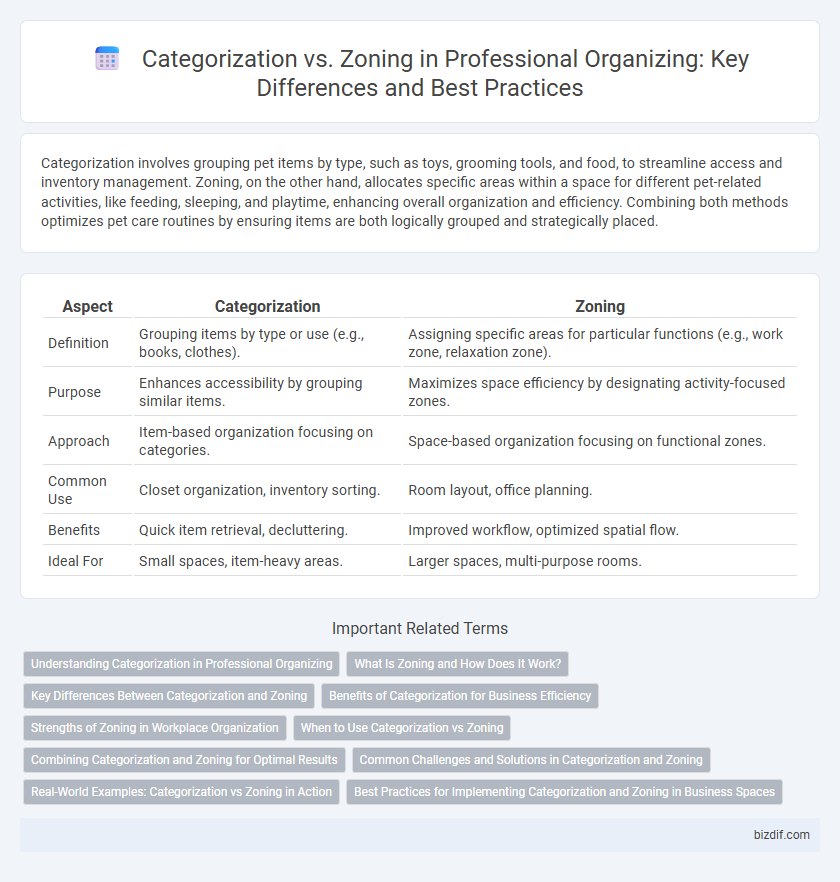Categorization involves grouping pet items by type, such as toys, grooming tools, and food, to streamline access and inventory management. Zoning, on the other hand, allocates specific areas within a space for different pet-related activities, like feeding, sleeping, and playtime, enhancing overall organization and efficiency. Combining both methods optimizes pet care routines by ensuring items are both logically grouped and strategically placed.
Table of Comparison
| Aspect | Categorization | Zoning |
|---|---|---|
| Definition | Grouping items by type or use (e.g., books, clothes). | Assigning specific areas for particular functions (e.g., work zone, relaxation zone). |
| Purpose | Enhances accessibility by grouping similar items. | Maximizes space efficiency by designating activity-focused zones. |
| Approach | Item-based organization focusing on categories. | Space-based organization focusing on functional zones. |
| Common Use | Closet organization, inventory sorting. | Room layout, office planning. |
| Benefits | Quick item retrieval, decluttering. | Improved workflow, optimized spatial flow. |
| Ideal For | Small spaces, item-heavy areas. | Larger spaces, multi-purpose rooms. |
Understanding Categorization in Professional Organizing
Categorization in professional organizing involves grouping items based on shared characteristics, such as function, frequency of use, or type, to create a logical system that enhances accessibility and efficiency. This method improves decision-making by enabling organizers to identify redundant or unnecessary items and streamline storage solutions. Unlike zoning, which assigns specific areas for activity, categorization prioritizes how items relate to one another, facilitating a more intuitive and sustainable organizational structure.
What Is Zoning and How Does It Work?
Zoning in professional organizing involves dividing a space into specific areas based on function, such as creating separate zones for work, relaxation, and storage. This method enhances efficiency by grouping related items together, making it easier to locate and use them within their designated zones. Effective zoning reduces clutter and increases productivity by ensuring each activity has a dedicated, well-organized area.
Key Differences Between Categorization and Zoning
Categorization involves grouping items by similarities such as type, purpose, or frequency of use, while zoning focuses on defining specific areas or spaces for particular activities or functions within a room or building. Categorization enhances accessibility through logical item grouping, whereas zoning optimizes spatial layout to improve workflow and usability. Understanding these key differences helps professional organizers create both efficient storage systems and functional living or working environments.
Benefits of Categorization for Business Efficiency
Categorization enhances business efficiency by systematically grouping similar items, enabling faster retrieval and streamlined inventory management. This method reduces decision fatigue and minimizes errors by providing clear, logical groupings that align with operational workflows. Improved categorization supports data-driven insights, allowing businesses to optimize resources and boost productivity.
Strengths of Zoning in Workplace Organization
Zoning in workplace organization enhances productivity by grouping related tasks and functions within specific areas, reducing time spent searching for materials or information. This method supports clearer spatial orientation and promotes efficient workflow by designating dedicated zones for collaboration, focused work, and resource storage. By minimizing clutter and distractions, zoning fosters a structured environment that improves employee focus and overall operational efficiency.
When to Use Categorization vs Zoning
Categorization is best used when managing similar items that can be grouped by type, such as organizing books, clothes, or kitchen utensils, allowing for easy retrieval and inventory. Zoning works well in spaces that require function-based areas, like designating separate zones in a home office for work, storage, and relaxation to enhance productivity. Use categorization for item-based sorting and zoning for spatial arrangement to optimize organization efficiency.
Combining Categorization and Zoning for Optimal Results
Combining categorization and zoning enhances professional organizing by grouping similar items together within designated areas, promoting both accessibility and order. This hybrid approach leverages categorization's strength in item identification with zoning's spatial efficiency, resulting in streamlined workflows and reduced clutter. Optimizing storage solutions through this synergy improves usability and maintains long-term organization in homes and offices.
Common Challenges and Solutions in Categorization and Zoning
Common challenges in categorization and zoning include overlapping categories that cause confusion, inefficient use of space, and difficulty accessing items quickly. Solutions involve clearly defining criteria for each category, creating distinct zones based on function or frequency of use, and implementing consistent labeling systems to improve navigation and retrieval. Employing modular storage units and regularly reassessing the organization plan also enhances adaptability and maintains order.
Real-World Examples: Categorization vs Zoning in Action
Professional organizers often utilize categorization to group items by type, such as grouping all books together, while zoning arranges these groups according to their function within a space, like creating a reading zone in a living room. For instance, in kitchen organization, categorization might involve sorting utensils, cookware, and pantry items separately, whereas zoning places frequently used cooking tools near the stove and baking supplies closer to the counter prep area. This real-world application of categorization versus zoning enhances efficiency by aligning item storage with practical usage patterns.
Best Practices for Implementing Categorization and Zoning in Business Spaces
Effective professional organizing in business spaces hinges on the strategic use of categorization and zoning to enhance workflow and productivity. Categorization involves grouping similar items or tasks to streamline access, while zoning designates specific areas for distinct functions, reducing clutter and confusion. Best practices include assessing spatial requirements, incorporating employee input for functional relevance, and regularly reviewing zones and categories to adapt to evolving business needs.
Categorization vs Zoning Infographic

 bizdif.com
bizdif.com